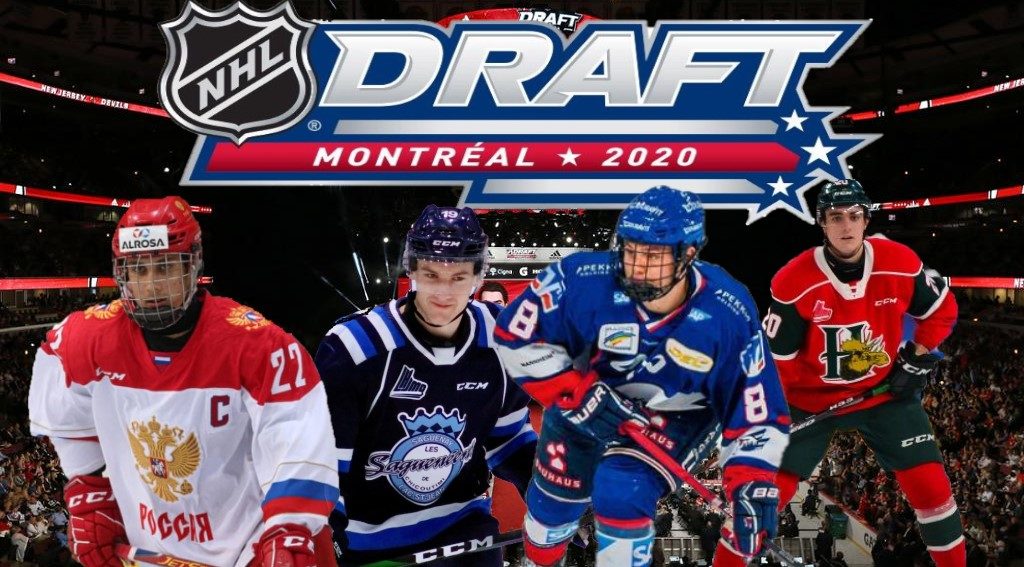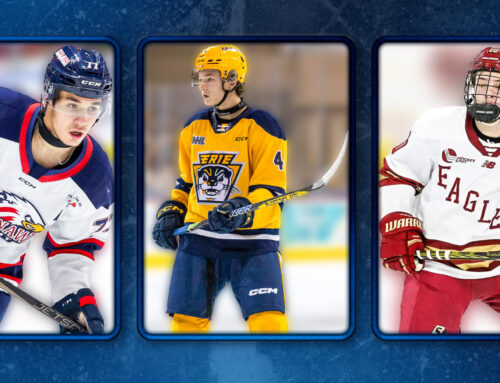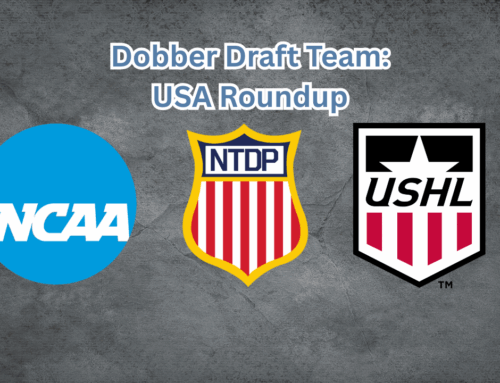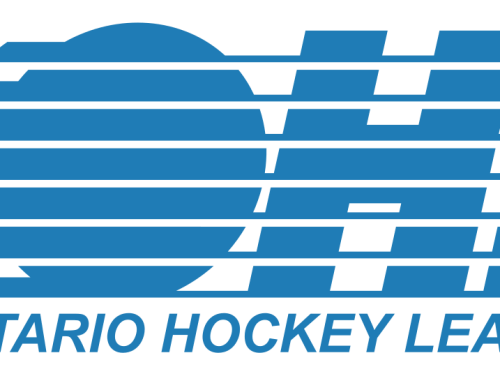February Draft Report: Risers and Fallers
Tony Ferrari
2020-02-26
Welcome to the February edition of the 2020 NHL Draft Report! This monthly column will take an in-depth look at the prospects eligible for the 2020 NHL Draft. Each month we will have a feature story, prospect spotlight and a “Team of the Month”. If there is any prospect you’d like to hear a bit more about, let us know!
Risers and Fallers
Every year draft analysts and pundits come out with rankings at various points of the year but the big watermarks have always been preseason, mid-season and the final rankings. We are now just past the mid-point of the season and we have an excellent chance to look back and see who has been rising up draft boards and who has fallen off from the start of the year. Thankfully, this is made much easier because of Colin Cudmore’s work. Colin collects rankings from many of the most credible and reliable sources of draft knowledge and he consolidates the lists to come up with one of the leading consensus rankings in the draft world. A full explanation of the project can be found here.
Players on the Rise
Let’s start with some positivity and take a look at the players on the rise. These players have all been rising up draft boards throughout the season and there are a variety of reasons why but the two primary reasons they’ve shot up rankings are either they’ve simply outproduced expectations or they weren’t scouted highly enough prior to this season. In order to understand the numbers in the ‘Diff’ column, a brief explanation should be given. This is a numerical representation of the player’s change or difference in their draft value based on a variety of rankings that Colin collects from some of the best names in the world of prospect evaluations from Dobber Prospects headman Cam Robinson to Corey Pronman of The Athletic. There are rankings from individuals to outlets such as my own personal rankings to the rankings from Future Considerations. The ‘Draft Value’ is based on the work of Michael Schuckers who was able to use data from previous draft picks and assign a value based on the production gained from players selected at their positions. These values range from 917 (1st overall) to roughly 51 (210th overall). For further information about this project, you can find his full analysis here. For the purposes of this exercise, we are going to look at the players who have been on the rise (and fall) from September until present day.
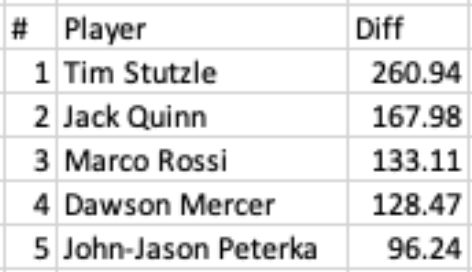
Biggest Risers for the 2020 Draft from September 1st, 2019 – February 16, 2020 courtesy of Colin Cudmore.
In a revelation that is likely a shock to very few, Tim Stützle is the player who has been on the biggest rise in draft value. While outside of the top-15 in most rankings to start the year, outside of the first-round on some boards, he seems to be destined for a top-5 pick now. While that rise of 5-10 picks doesn’t seem like much, it gets much more difficult to move up the board when you’re competing at the top. Stützle has been putting his talent on display, solidifying himself as one of the best skaters in the draft and among the players with the purest speed. With and without the puck Stützle (#8 below) is able to blow by opposing players on his way to embarrassing defenders with his high-end puck skills and offensive IQ that ranks among the best in class. He identifies weaknesses and takes advantage of them with a predatory instinct.
The biggest reason a player like this wasn’t as high in September as he is now is that he plays in the top German men’s league, the DEL. This happens to be the same league Moritz Seider played in last season on his way to rising up the draft boards. The DEL hasn’t had much of a history of getting players selected highly in the NHL draft but things seem to be changing with players such as Seider, Stützle and John-Jason Peterka, who we will talk about in just a bit. Stützle has been producing at nearly a point-per-game in the DEL which has helped get him noticed as well as a very strong World Juniors for the German U20 team. A from a first-round possibility to top-5 probability, Stützle has seen his draft ranking balloon over the course of the year.
The next player on our list is Ottawa 67’s (OHL) goal-scoring machine, Jack Quinn. Currently sitting at 46 goals through 55 games, he is currently second in the entire CHL. That kind of production couldn’t have been expected after only scoring 12 goals in 61 games last season. Quinn has shown the ability to find the back of the net consistently and with a variety of shots. His bread and butter is the snap shot. He is able to get off his stick to the back of the net lightning quick. He shoots from all over the ice but he excels when he gets in below the dots. His game is predicated on his goal-scoring ability because as a passer he doesn’t make much of an impact. Prior to the season, it was a stretch to see him in the top half of the second round of most rankings, usually settling in as a top-60 prospect but definitely towards the backend of that range. Today, he’s been pushing higher into the first round, even garnering top-20 consideration by many. He may be a one-trick pony at times but is that trick ever good.
The next man up on our list is Quinn’s teammate in Ottawa, Marco Rossi (#23 above). The leading scorer in the entire CHL has produced at an impressive rate all season. He missed time due to an injury early in the year and also sat out for a suspension but the 67’s star has still been able to outpace every player in the CHL this year, including Alexis Lafreniere. Coming into the year there were concerns around Rossi that had to do with his size (5’9″) or the fact that he was just eight days away from being eligible for last year’s draft but Rossi has made each of those factors irrelevant over the course of the year. His size hasn’t been an issue because he is built like a fridge on skates. He has the “Crosby Thighs” which help him stay strong on the puck and he has the overall strength to protect the puck. He plays with a tenacity that doesn’t allow for opponents to get the puck back once the Swiss star has it on his stick.
Next up on the list of biggest risers is Dawson Mercer. One of the biggest surprises on the Canadian World Junior team, Mercer has put together a stellar season in the QMJHL. Starting the year with the Drummondville Voltigeurs, Mercer had 42 points in his first 26 games in the lead up to the World Juniors. His production was among the best from a draft-eligible player across the CHL. Mercer has an excellent shot that probably doesn’t get talked about enough and his advanced IQ helps him take advatage of other team’s mistakes. Mercer is the kind of player that has just steadily risen throughout the year based on some excellent play. His rise could be nearing an end and leveling off a bit as he hasn’t had quite the same impact with the Chicoutimi Saguenéens as he has slowed down to just a point-per-game pace. Although that is still quite impressive, especially on a new team, he may not be able to continue his ascent unless he starts producing at the rate he was to start the year in Drummondville.
We finally get to John-Jason Peterka (#77 in the video above) who rounds out the top-five. Suffering from the same fate that Stützle dealt with by playing his junior hockey in Germany and then moving onto the DEL, the German men’s league, in his draft year. Peterka was seldom ranked in early rankings but has begun to find his way onto rankings. His big bump came at the World Juniors where he and Stützle were among the best forwards for the German team. They were both true difference makers but Peterka seemed to score goals with a bit of flash to them. He displayed his high-end shooting ability and he has a knack for finding the soft spots in the defense by constantly moving in and out of the slot, never allowing defenders to sit on his positioning. While his ranking is still varied among analysts, Peterka has found his way into the late first-round on quite a few boards and in the second round of the majority.
Players Falling Down the Board
Now is the other end of the spectrum. These are the players who have fallen on draft boards for a variety of reasons from injuries to poor performance. A couple of these players have dealt with serious injuries that have limited the number of games that they have been able to play. A few have been divisive prospects that haven’t quite sold anyone on whether the raw tools can come together. Each of these players is on this list because coming into the season, the draft world had high expectations and hopes for these players and for one reason or another, they just haven’t been able to pay off that preseason faith.
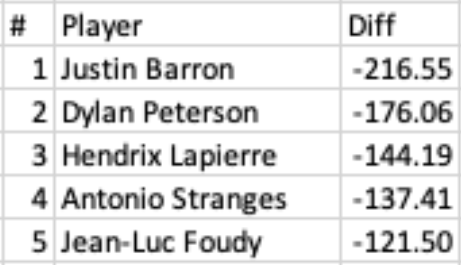
Biggest Fallers for the 2020 Draft from September 1st, 2019 – February 16, 2020 courtesy of Colin Cudmore.
Justin Barron is the unfortunate name that starts this side of things. The right-handed blueliner came into the year as the favourite to be the second defender selected. He plays in all situations and has the mobility needed in the modern game. Barron’s play seemed to take a step back early in the year. For the first couple of months of the season, Barron looked a step behind. His defensive game wasn’t quite there. While it looked calm, cool and collected last season, he seemed out of sorts at times in his own end. His offensive production seemed to stagnate from the year before as well. Then the big blow came. Blood clots. The high-end defensive prospect has been battling through them and figuring out what his best mode of treatment is. Barron is set to make his return to the ice on February 26th, for the first time since early December. This is a welcome sign and could slow the slide for Barron who could have been dealing with the blood clots from the start of the year.
The next member of the group could be one of the most physically gifted players in the 2020 draft class. Dylan Peterson (#15 above) is one of the hardest prospects in the draft to evaluate. He has embraced the power forward role this season and his 6’4″ frame has allowed him to be successful at it. He is a good skater when he uses his lower body to generate power but there are times when he gets a bit too upright in his stride. His shot is very good and has a heaviness to it. He has the ability to drive the net, holding off defenders on his way there. His ability to play the cycle is very strong and he plays off the wall very well. The biggest problem for Peterson is that the production hasn’t been there. He seems to be doing things the right way, he has the skating and offensive game to put up some points but just hasn’t been able to find it. If you haven’t watched Peterson play, you look at his production and make assumptions but with multiple viewings and keying in on Peterson a number of times, you will see how often Peterson’s luck seems to fall the wrong way. Shots off posts, teammates missing tap-ins and pucks hoping on him at the last second. Some team may draft Peterson and end up getting a very good power forward when his luck rebounds.
The simplest case of why a player has fallen down draft boards might be next up in Hendrix Lapierre. The high-skill forward was a top-15 prospect in many eyes at the start of the season, even seeing time in the top-five of some lists. Lapierre is a good skater, excellent playmaker and has a decent shot as well. His vision and IQ propel his silky-smooth passing and help make every player on the ice with him better. The simple fact that of the matter is that Hendrix Lapierre has only played in 19 games this season. This is due to the fact that he suffered his second concussion of the season and third in eight months. While Lapierre has been head-ache free and close to symptom-free, he has chosen to hold himself out a bit longer to make sure that his long-term health is in order so that his career doesn’t get shortened by another concussion in such a short time frame. Lapierre is a top-15 talent that could go in the late first-round or even early in the second. If all works out, some team could come away with a steal all thanks to a mature choice by a young man looking to prolong his career before it was ended prematurely.
The next player is an example of a player that mesmerized us with some flash. Antonio Stranges (#40 below) has been a prospect that analysts have been divided over all year long. Stranges has the ability to wow with his insane puck skills and the impressive ’10-2′ skating style that looks impressive but hasn’t yet been pioneered by anyone as a consistent weapon in the NHL because it generally leads to players being knocked off balance. It allows a player to stay to the outside and still look like a threat. What Stranges does that differentiates himself from previous fancy footed players is that he often uses the ’10-2′ stride to build speed through the neutral zone. When he drives to the middle of the ice with it, he can be an effective player but he doesn’t do it nearly enough. He has the puck on a string at times, often looking like a player toying with his competition but often can’t translate it against the better competition. While some view Stranges as a first-round pick, there are others who think he may be nearly undraftable. The truth likely lies somewhere in the middle which is why the preseason top-12 pick settles back to the position he likely should have always been in late in the first or early in the second round.
The player rounding out the top-five here is Jean Luc Foudy of the Windsor Spitfires. Foudy might be one of the fastest players in this draft but has regressed from his production last season. He has the blazing speed to back defenders off and burn them wide when they don’t. Foudy is an outstanding playmaker who has the ability to pinpoint a passing option and find them through traffic. Foudy’s biggest issue is that he plays on the perimeter far too often. His speed is muted if he’s traveling much further distances by circling the zone and staying outside of the circles. His tape-to-tape passing ability is also muted as he’s often trying to force passes to the middle of the ice from the half wall. When Foudy has driven the net and attacking the slot with his speed, he becomes a truly special talent. When he doesn’t, which he hasn’t often enough this season, he is just a fast player who has a ton of tools. Foudy is a first-round talent but likely won’t be chosen until the second round because of the questions of whether or not he will ever find the desire to get to the middle of the ice, making good on his potential.
*******
Prospect Spotlight: Marat Khusnutdinov
One of the most interesting prospects in the draft comes from Russia in the form of high-flying forward Marat Khusnutdinov. If you’ve ever seen him play, you know that he plays a very fun and exciting game. For reference, in each of the videos below Khusnutdinov is number 22. Khusnutdinov plays uptempo, constantly driving the play towards the opposition’s net. He makes you inch towards the edge of your seat if you’re even sitting down still. What Khusnutdinov does on the ice, most players don’t even attempt to try.

Player Information courtesy of Elite Prospects
Khusnutdinov has an intriguing offensive profile. He plays without fear in the offensive zone. He blends a willingness to try things with an impressive rate of success. Khusnutdinov is a good skater who is excellent on his edges. When he gets skating downhill at an opponent, it forces his opposition to read and react quickly. What makes Khusnutdinov a special player offensively is that he reads and reacts even faster than his opponent. If he is driving wide and the defender makes the appropriate read, Khusnutdinov will pull the puck inside and drive the net through the slot. His hands are excellent in tight, needing very little space to pull something out of his bag of tricks.
The MHL star is a true dual-threat with the puck on his stick. His shot is good but will likely need to build up a bit of strength to get it to the next level. Where Khusnutdinov scores many of his goals is around the net. He works his way in tight and has a quick release and the ability to elevate the puck from in tight. At this point, he is more of a crafty goal-scorer than a lethal shooter but his shot has been above average at each level. His playmaking ability is his most dangerous weapon. He completes his passes at a high rate and he passes a ton. Based on some data provided by Will Scouch of Scouching.ca Khusnutdinov attempts 126 passes/60 minutes of play and completes his passes at an 80% clip which is unbelievably efficient. He generates passes to the middle of the ice with volume and does an excellent job of using his skating to draw defenders, giving teammates much better looks. He commands the ice and directs traffic extremely well offensively, especially as his role has been growing with SKA-1946 St. Petersburg over the course of the season.
Far too often are small players immediately deemed poor or average defensive players but Marat Khusnutdinov is far more than that. Khusnutdinov isn’t likely to ever become a heavy hitter but he doesn’t need to be, especially with today’s game leaning into the speed and skill aspects of the modern players. His ability to apply pressure to opponents in the defensive zone is impressive. He does it with haste, closing off the time and space that the puck carrier has, forcing them into a decision that often ends with the puck back on Khusnutdinov’s stick. He utilizes his skating and skill to stay in front of attackers, keeping them to the outside. Khusnutdinov covers a lot of ground and plays an aggressive style of pressuring defense and at times this leads to him running around a bit. He likely refines that a bit at the pro level. His advanced stick work in the defensive zone might be his most underrated aspect defensively. He uses crafty stickwork along the boards and in open space, stripping the opposition of the puck and turning it up ice quickly.
Khusnutdinov turns the puck up ice quickly and does it with control. Referencing the excellent work of Will Scouch yet again, 80% of his offensive transitions are done with control and 35% of defensive transitions controlled. What this means is that Khusnutdinov has the puck on his stick in transition quite a bit. Through the neutral zone, Khusnutdinov’s vision and on-ice awareness allow him to identify the weak point in a defensive unit’s neutral zone play and attack it. He does so with the puck on his stick, electing to not dump and chase but rather keep the puck, outskate the opposition and set himself and his teammates up for more sustained and dangerous offensive threats.
The biggest reason that Marat Khusnutdinov isn’t discussed more as a prospect that is a viable option in the first round is that he plays in the mystery that is the MHL primarily. The MHL is an odd league in that there are teams that are very high-end and others that look like they should be two divisions lower. This can lead to some very skewed numbers at times. For reference, the data tracked by Will Scouch was from games against top-end teams in the league which helps validate those numbers. Another reason some scouts, particularly old-school scouts, are down on the creative Russian is the fact that he is only 5’9″ and 165lbs. This raises some concerns for scouts but with more and more small players not only getting to the NHL but driving play and producing at rates near the top of the league, it shouldn’t be an issue for Khusnutdinov who certainly doesn’t play with the timidness that many associates with smaller players.
The moral of the story with Marat is that whatever team drafts him, probably later than he should be taken, it looks like they will end up with a player who can not only play in all situations excel in them at the next level with some further development and growth. His game profiles well and translates to the modern pro game. He is an attacking player whose game relies on his uptempo play and pressuring style all over the ice. Whether offensively or defensively, Marat Khusnutdinov takes no shifts off and plays in your face. His creativity and willingness to get his teammates involved leads to extremely fun hockey to watch. Marat Khusnutdinov will be in the first-round in my next rankings and he should be on yours as well.
Team of the Month: All-Shorty Team (Under 5’10”)
F – Marco Rossi, C, Ottawa 67s (OHL) 5’9″
F – Tyler Tullio, C/RW, Oshawa Generals (OHL) 5’9″
F – Alexander Pashin, C/W, Tolpar Ufa (MHL) 5’8″
D – Emil Andrae, LHD, HV71 J20 (SuperElit) 5’9
D – Jacob Dion, LHD, Drummondville Voltigeurs (QMJHL) 5’9″
G – Darren Pang, G, Belleville Bulls (OHL) 5’5″
The All-Shorty team has an insane amount of talent on it and there are a bunch of players that were left off. Players like Thomas Bordeleau, Kasper Simontaival, and Zion Nybeck, among others, could have easily made this team. It’s best that we start with the obvious. Darren Pang is the netminder for Team Shorty. This seems a bit odd since he hasn’t played hockey in almost three decades. The problem was, there are no short goalies anymore. When looking at the netminders eligible for this draft, there are no standout goalies under 6’0″. There really aren’t any goalies under 6’0″ getting drafted nowadays and this year certainly doesn’t have any. For that reason, it makes sense to give one of the better colour analysts in the game a shoutout. 5’5″ and he played parts of three years in the NHL. That’s impressive on a level many of us don’t even fathom.
On the back end, Team Shorty isn’t going to outmuscle you but what they will do is blow by you and push the pace of the game to a point that will wear their opponent down. Emil Andrae is an extremely skilled blueliner who excels in the offensive zone. His hockey IQ is off the charts and he has the skill to use it to its full potential. He defends well when he uses his skating and stick work, separating the man from the puck and then moving it the other way. Andrae is an excellent puck carrier in transition, showing the elusive skating and puck skills to work his way through the traffic in the neutral zone. His ability to flip the ice and put his team in a position to succeed offensively is an impressive skill. In the offensive zone, Andrae’s vision and passing ability make every player he’s on the ice with dangerous. Andrae makes everyone on the ice with him better because of his ability to distribute the puck to the most dangerous player or keep it himself to take a shot if he is that player. His partner on Team Shorty is a player who is all offense. Jacob Dion is a silky smooth skater who likes to take chances in the offensive zone. He sees the ice well and gets his teammates involved when the puck is on his stick. He likes to shoot the puck as well, utilizing a wicked snapshot that routinely beats goalies or creates rebounds around the net. He has a few flaws defensively, especially with his lack of effort at times in his own zone. His offensive toolset is impressive nonetheless.
The forward group is a blend of high-end skill and high-end motors. The key to this trio is that they all play slightly different games. Tullio is the high-energy first man in on the forecheck who can load up and blast the puck. He has a very good shot and his compete level is never in question. Tullio plays bigger than he is, constantly hounding the other team for the puck. He disrupts the other team’s breakout taking away space from defenders with the puck and forcing them into decisions. Pashin can play on the wing opposite of Tullio, bringing the same high motor with some better raw skills. His pucks skills are impressive, with the ability to toy with his opponents as he works his way into space. He does an excellent job of pressuring the opposition as they try to come through the neutral zone, turning the puck over and getting behind defenses regularly.
With Marco Rossi at center, this would be a line that caves their opponents in on both ends of the ice. Rossi is an excellent two-way center who has one of the highest offensive ceilings in the draft. Easily the most high-end prospect on the All-Shorty team, Rossi has been producing at a rate comparable to Alexis Lafrenière (2.10 PPG vs. 2.14 PPG). He has a sturdy base and doesn’t allow his size to be a factor. Rossi already possesses the strength needed to fend off much larger defenders showing that his size is just a number. Rossi can do it all, whether you need a playmaker or a goal-scorer, he would be able to provide whatever a team needs and plays in all situations. In this line, you get a unit that can help make up for the defensive struggles that the defensive pairing on Team Shorty and also continue to be catalysts offensively.
*******
If you have an idea for a feature story for next month, have a suggestion for the ‘Team of the Month’ or prospect spotlight, reach out! Let me know! I can always be reached on Twitter @TheTonyFerrari! Thank you again for reading this, whether you sat down with a pot of coffee and consumed it in one sitting or split it up over a few visits, I appreciate it all!
Make sure you check out the full Dobber Prospects 2020 NHL DRAFT PAGE! There are over 60 player profiles and a ton more draft content including the January Draft Report with a full breakdown of my Top-100 Rankings with video and analysis on 60+ players including nearly every player in the top-40!


